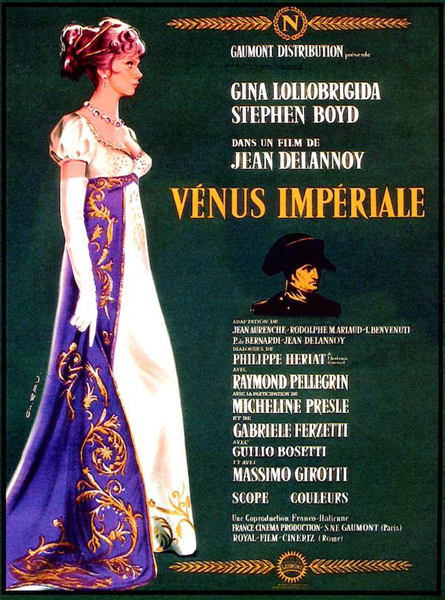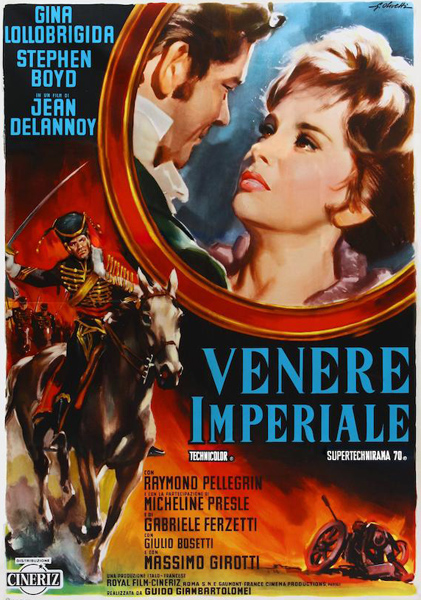"Kaiserliche Venus" Presented in 70mm |
Read more at in70mm.com The 70mm Newsletter |
| Written by: Peter Kohl | Date: 22.11.2021 |
 "Imperial
Venus" poster from movieposterdb.com "Imperial
Venus" poster from movieposterdb.comSaturday, December 4th at 15:00 at the Schauburg Cinerama, Karlsruhe "La Lollo", the star of Italy, has long been a seductive Venus herself as she takes the affairs of the heart of Napoleon's sister to her voluptuous boobs. Named "Gina nazionale" in 1962, she has already filmed with greats such as Yul Brynner or Anthony Quinn and was the most erotic Esmeralda in the entire bell tower - in short: Gina Lollobrigida is at her peak; and in retrospect, already a bit beyond it. Even though in the year before "Imperial Venus" she was to accept a "Golden Globe" as "Most Popular Female Actress in the World" and in the following years was to stand in front of the camera with Rock Hudson, Sean Connery, Sir Alec Guinness and Telly Savalas. A film star in slow extinction, for Lollobrigida got a more than equal rival in the beautiful Sophia Loren, who, moreover, did not have to constantly deal with doubts about her acting qualities. However, in Jean Delannoy's historical romp about politics, love, passion, greed for power and betrayal, Gina Lollobrigida still delights as an unreservedly radiant linchpin. And for 140 minutes she flirts unerringly with the wrong people. She wants to marry the first love she meets. But Napoleon (Raymond Pellegrin) is against it because his favourite sister's chosen one, Stanislas Fréron (Gabriele Ferzetti), at 34, is not only more than twice her age but also a confidant of Robespierre. Instead, he marries Joséphine (Micheline Presle), still a general at the time, without Mother Bonaparte's (Lilla Brignone) blessing; and, in the opinion of his big brother, General Emanuel Leclerc (Massimo Girotti) would be a much better match for Paolina. Before the marriage in 1797, she meets Jules de Canouville (Stephen Boyd). However, the dapper Joséphine makes a pass at him and steals him away from her sister-in-law. Paolina takes her revenge: she lets her brother in on the wrong game and goes with her husband to San Domingo, where he is supposed to put down an uprising. She bears him a son, who is buried in 1803, just like his father, when Paolina ties the knot with the handsome but impotent Count Camillo Borghese (Giulio Bosetti). This time Madame almost dies herself, but from boredom and longing for Paris. She has herself immortalised as Venus in Rome by the sculptor Antonio Canova (Gianni Santuccio) and has to wear the train of the hated Joséphine at Napoleon's coronation in 1804 together with her sisters. Various love affairs and other pleasures mark the rest of her life until, by chance, she once again meets the colonel of her youth. Canouville is supposed to be her great love, but Napoleon is jealous to the highest degree. French director Jean Delannoy also knows his Venus well. In 1956 he made the above-average Victor Hugo adaptation "The Hunchback of Notre-Dame" with Gina Lollobrigida. This time the result is limited to a lavish costume drama whose title heroine embodies Lollobrigida as spiritedly as she does seductively, but which owes its classification as a historical film - the authenticity of which, incidentally, was never the point - solely to the fact that contemporary world history and its conflicts are used as a backdrop. In his colourful series of images, Jean Delannoy primarily takes up the essential stages of Paolina Bonaparte, who died in 1825 and who, unlike her siblings, devoted herself solely to beauty and love and never achieved political significance. The same applies to the film. Italy, France 1962 Director: Jean Delannoy Cast: Gina Lollobrigida, Stephen Boyd, Gabriele Ferzetti 135 minutes Rated: from 16 years Presented in 70mm (1:2,21) / 6-channel stereo magnetic sound – Produced in Super Technirama 70 (35mm negative film / 8-perf horizontal) German version 140 minutes "Imperial Venus" was photographed in 35mm Technirama, and presented in Super Technirama 70. |
More in 70mm reading: Schauburg Cinerama, Karlsruhe, Germany. Home of The Todd-AO Festival Now showing in 70mm in a theatre near you! History of Technirama Super Technirama 70 |
 "Imperial
Venus" poster from movieposterdb.com "Imperial
Venus" poster from movieposterdb.com„La Lollo“, der Augenstern vom Stiefel, ist längst selbst eine verführerische Venus als sie sich die Herzensangelegenheiten von Napoleons Schwester zur üppigen Brust nimmt. Zur „Gina nazionale“ gekürt, hat sie 1962 bereits mit Größen wie Yul Brynner oder Anthony Quinn gedreht und war die erotischste Esmeralda im gesamten Glockenturm – kurz: Gina Lollobrigida ist auf dem Höhepunkt; und im Nachhinein betrachtet schon ein Stückchen darüber hinaus. Auch wenn sie im Jahr vor „Kaiserliche Venus“ noch einen „Golden Globe“ als „Beliebteste weibliche Schauspielerin der Welt“ entgegennehmen und in den folgenden Jahren mit Rock Hudson, Sean Connery, Sir Alec Guinness und Telly Savalas vor der Kamera stehen sollte. Ein Filmstar im langsamen Erlöschen, denn die Lollobrigida hat mit der schönen Sophia Loren eine mehr als ebenbürtige Rivalin bekommen, die sich außerdem nicht ständig mit Anzweiflungen ihrer schauspielerischen Qualitäten herumschlagen muss. In Jean Delannoys Historienreigen um Politik, Liebe, Leidenschaft, Machtgier und Verrat erfreut Gina Lollobrigida allerdings noch als uneingeschränkt strahlender Dreh- und Angelpunkt. Und poussiert 140 Minuten lang zielsicher mit den Falschen. Gleich die erstbeste Liebe will sie heiraten. Doch Napoleon (Raymond Pellegrin) ist dagegen, weil der Auserwählte seiner Lieblingsschwester, Stanislas Fréron (Gabriele Ferzetti), mit 34 nicht nur mehr als doppelt so alt, sondern zudem ein Vertrauter Robespierres ist. Stattdessen ehelicht er, zu dieser Zeit noch General, ohne Mutter Bonapartes (Lilla Brignone) Segen seine Joséphine (Micheline Presle); und viel besser zu Paolina passen würde doch, so die Ansicht des großen Bruders, General Emanuel Leclerc (Massimo Girotti). Bevor es 1797 zur Vermählung kommt, lernt sie Jules de Canouville (Stephen Boyd) kennen. An den macht sich jedoch die adrette Joséphine heran und spannt ihn der Schwägerin aus. Paolina rächt sich: Sie weiht ihren Bruder ins falsche Spiel ein und geht mit ihrem Ehemann nach San Domingo, wo dieser einen Aufstand niederschlagen soll. Sie gebärt ihm einen Sohn, der im Jahre 1803 ebenso einen Grabstein gesetzt bekommen hat wie sein Vater, als Paolina mit dem schönen, aber impotenten Grafen Camillo Borghese (Giulio Bosetti) den nächsten Bund fürs Leben schließt. Diesmal stirbt Madame um ein Haar selbst; allerdings vor Langeweile und Sehnsucht nach Paris. Sie lässt sich in Rom vom Bildhauer Antonio Canova (Gianni Santuccio) als Venus verewigen und muss 1804 bei Napoleons Krönung zusammen mit ihren Schwestern die Schleppe der verhassten Joséphine tragen. Diverse Liebesaffären und andere Vergnügungen prägen ihr weiteres Leben, bis sie durch einen Zufall erneut auf den Oberst ihrer Jugendzeit trifft. Canouville soll ihre große Liebe sein, doch Napoleon ist in höchstem Maße eifersüchtig. Auch der französische Regisseur Jean Delannoy kennt seine Venus gut. 1956 hatte er mit Gina Lollobrigida die überdurchschnittliche Victor-Hugo-Verfilmung „Der Glöckner von Notre-Dame“ gedreht. Diesmal beschränkt sich das Ergebnis auf ein aufwändig ausgestattetes Kostümmelodram, dessen Titelheldin die Lollobrigida zwar ebenso temperamentvoll wie verführerisch verkörpert, das seine Einordnung als Historienfilm – um dessen Authentizität es nebenbei bemerkt nie ging – aber einzig der Tatsache verdankt, dass man die zeitgenössische Weltgeschichte und ihre Konflikte als Kulisse (be-)nutzt. Jean Delannoy greift in seinem bunten Bilderreigen in erster Linie die wesentlichen Stationen der 1825 gestorbenen Paolina Bonaparte auf, die sich anders als ihre Geschwister einzig der Schönheit und der Liebe verschrieben und nie politische Bedeutung erlangt hat. Für die filmische gilt selbiges. Italien, Frankreich 1962 Regie: Jean Delannoy Darsteller: Gina Lollobrigida, Stephen Boyd, Gabriele Ferzetti 135 Minuten ab 16 Jahren Präsentiert in 70mm (1:2,21) / 6- Kanal Stereo Magnetton - Aufgenommen in Super Technirama 70 (35mm Negativfilm / 8-Perf horizontal) Deutsche Fassung 140 Minuten |
|
| Go: back - top - back issues - news index Updated 22-01-25 |
